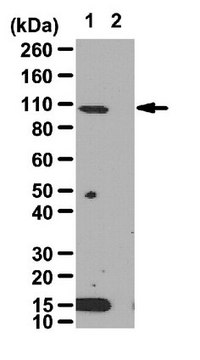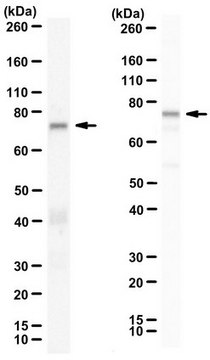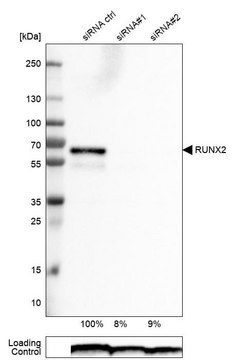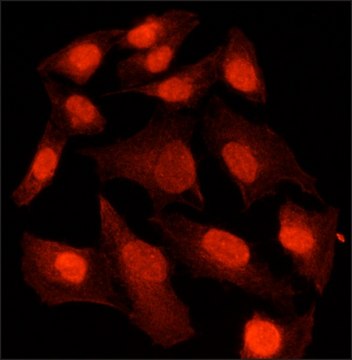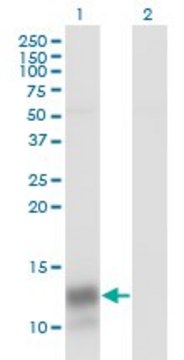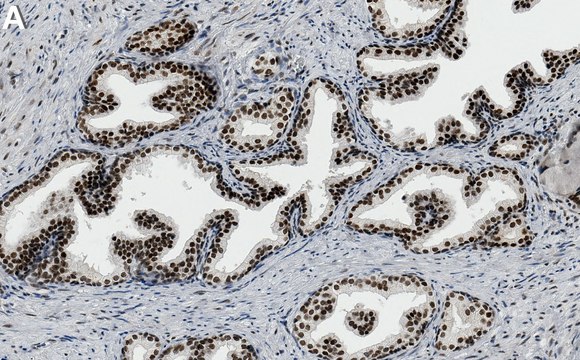Recommended Products
biological source
rabbit
Quality Level
antibody form
purified antibody
antibody product type
primary antibodies
clone
polyclonal
species reactivity
mouse, human
packaging
antibody small pack of 25 μg
technique(s)
ChIP: suitable (ChIP-chip)
immunofluorescence: suitable
western blot: suitable
isotype
IgG
NCBI accession no.
target post-translational modification
unmodified
Gene Information
human ... MEIS1(4211)
mouse ... Meis1(17268)
General description
Homeobox protein Meis1 (UniProt: Q60954-1; P97367-2 and P97367-3; also known as Myeloid ecotropic viral integration site 1 (Meis1) and Meis1-related protein 1) is encoded by the Meis1 gene (Gene ID: 17268). Meis proteins act as transcription factors that are orthologous to the Drosophila homothorax (Hth) protein. Meis protein contain a TALE (three-amino-acid loop extension) sub-class of the homeodomain that binds to DNA. Meis protein directly bind to Pbx proteins and the Meis/Pbx protein complex binds to DNA through respective Meis- and Pbx-consensus binding sites to regulate transcription. The Meis/Pbx complex plays important roles during development of multiple organs. In humans and mice, three homologues Meis1, Meis2 and Meis3 have been identified. Meis1 is expressed at high levels in the lung and at lower levels in the heart and brain. On the other hand, Meis 2 displays spatially restricted expression patterns in the developing nervous system, limbs, face, and in various viscera. In adult, it is mainly expressed in the brain and female genital tract, with a different distribution of the alternative splice forms in these organs. Pancreatic beta cells express both Meis1 and 2. Both Meis1 and 2 are expressed at high levels in all stages of embryonic development of mice (day 7 to 17). Deficiency of Meis1 or Meis 2 can lead to embryonic lethality. (Ref.: Machon, O et al. (2015). BMC Dev. Biol. 515:40).
Specificity
This rabbit polyclonal antibody detects Meis1 in human and murine cells. It targets an epitope within the C-terminal region.
Immunogen
Epitope: C-terminus
KLH-conjugated linear peptide corresponding 14 amino acids from the C-terminal region of Meis1.
Application
Anti-Meis1, Cat. No. ABE2864, is a highly specific rabbit polyclonal antibody that targets Homeobox protein Meis1 has been tested in Chromatin Immunoprecipitation (ChIP), Immunofluorescence, and Western Blotting.
Research Category
Epigenetics & Nuclear Function
Epigenetics & Nuclear Function
Western Blotting Analysis: 1 µg/mL of this antibody detected Meis1 in 10 µg of K562 cell lysate.
Immunofluorescence Analysis: A representative lot detected Meis1 in adjacent stage (St) 41 sagittal hindbrain and eye sections (Mercader, N., et. al. (2005). Development. 132(18):4131-42).
Western Blotting Analysis: A 1:800 dilution from a representative lot detected Meis1 in HEK293T cells transfectd with Meis1a (Courtesy of Dr.Valeria Azcoitia and Dr. Miguel Torres).
Chromatin Immunoprecipitation (ChIP) Analysis: A representative lot detected Meis1 in Chromatin Immunoprecipitation applications (Penkov, D., et. al. (2013). Cell Rep. 3(4):1321-33).
Western Blotting Analysis: A representative lot detected Meis1 in proximal, distal, and RA-treated distal blastemas (Mercader, N., et. al. (2005). Development. 132(18):4131-42).
Immunofluorescence Analysis: A representative lot detected Meis1 in adjacent stage (St) 41 sagittal hindbrain and eye sections (Mercader, N., et. al. (2005). Development. 132(18):4131-42).
Western Blotting Analysis: A 1:800 dilution from a representative lot detected Meis1 in HEK293T cells transfectd with Meis1a (Courtesy of Dr.Valeria Azcoitia and Dr. Miguel Torres).
Chromatin Immunoprecipitation (ChIP) Analysis: A representative lot detected Meis1 in Chromatin Immunoprecipitation applications (Penkov, D., et. al. (2013). Cell Rep. 3(4):1321-33).
Western Blotting Analysis: A representative lot detected Meis1 in proximal, distal, and RA-treated distal blastemas (Mercader, N., et. al. (2005). Development. 132(18):4131-42).
Quality
Evaluated by Western Blotting in HeLa cell lysate.
Western Blotting Analysis: 1 µg/mL of this antibody detected Meis1 in 10 µg of HeLa cell lysate.
Western Blotting Analysis: 1 µg/mL of this antibody detected Meis1 in 10 µg of HeLa cell lysate.
Target description
~52 kDa observed; 43.0 kDa (Meis1) calculated. Uncharacterized bands may be observed in some lysate(s).
Physical form
Format: Purified
Protein A purified
Purified rabbit polyclonal antibody in PBS with 0.05% sodium azide and 50% glycerol.
Storage and Stability
Stable for 1 year at -20°C from date of receipt.
Handling Recommendations: Upon receipt and prior to removing the cap, centrifuge the vial and gently mix the solution. Aliquot into microcentrifuge tubes and store at -20°C. Avoid repeated freeze/thaw cycles, which may damage IgG and affect product performance.
Handling Recommendations: Upon receipt and prior to removing the cap, centrifuge the vial and gently mix the solution. Aliquot into microcentrifuge tubes and store at -20°C. Avoid repeated freeze/thaw cycles, which may damage IgG and affect product performance.
Other Notes
Concentration: Please refer to lot specific datasheet.
Disclaimer
Unless otherwise stated in our catalog or other company documentation accompanying the product(s), our products are intended for research use only and are not to be used for any other purpose, which includes but is not limited to, unauthorized commercial uses, in vitro diagnostic uses, ex vivo or in vivo therapeutic uses or any type of consumption or application to humans or animals.
WGK
WGK 2
Flash Point(F)
Not applicable
Flash Point(C)
Not applicable
Certificates of Analysis (COA)
Search for Certificates of Analysis (COA) by entering the products Lot/Batch Number. Lot and Batch Numbers can be found on a product’s label following the words ‘Lot’ or ‘Batch’.
Already Own This Product?
Find documentation for the products that you have recently purchased in the Document Library.
Our team of scientists has experience in all areas of research including Life Science, Material Science, Chemical Synthesis, Chromatography, Analytical and many others.
Contact Technical Service